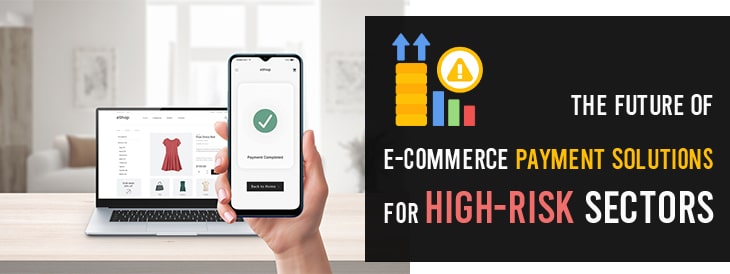The Future of E-commerce Payment Solutions for High-Risk Sectors
The Future of E-commerce Payment Solutions for High-Risk Sectors

Introduction to Sectors with Elevated Risk
In the fast-paced world of e-commerce, high-risk sectors face unique challenges when it comes to payment processing. Industries such as online gambling, adult entertainment, and cryptocurrency exchanges are often categorized as high-risk due to factors like chargeback rates, legal complexities, and reputational concerns. As these sectors continue to grow, finding effective ecommerce payment solutions becomes increasingly important to ensure smooth transactions and mitigate financial risks.
These industries often operate under heightened scrutiny and are more susceptible to fraud, which necessitates the need for robust payment solutions tailored to their specific needs. The future of e-commerce payment solutions for high-risk sectors will likely be shaped by innovations aimed at enhancing security, reliability, and compliance with ever-evolving regulations.
Some Related Blogs
- Understanding Compliance in High-Risk Payment Processing in 2024
- Optimizing Payment Processing: Top Solutions for High-Risk Business Owners
- A Step-by-Step Guide to Finding Payment Processors for High-Risk Industries
- How High-Risk Businesses Can Navigate Payment Processing Challenges
Existing Payment Methods
Currently, high-risk sectors rely on a combination of traditional and digital payment methods. Credit and debit cards remain popular due to their widespread acceptance and convenience. However, they come with significant limitations, particularly for businesses in high-risk sectors. High transaction fees, the potential for chargebacks, and the constant threat of fraud make these payment methods less than ideal for businesses already facing financial scrutiny.
Alternative payment options, such as e-wallets and cryptocurrency, have gained traction in recent years. E-wallets provide a level of security and convenience that traditional cards lack, while cryptocurrencies offer anonymity and reduced transaction fees. Despite their benefits, these alternatives also come with challenges, such as regulatory uncertainty and limited mainstream acceptance.
The reliance on traditional financial systems often exposes high-risk businesses to increased fees and stringent compliance requirements, which can stifle growth and limit their potential. This highlights the need for innovative solutions that address specific pain points.
High-risk sectors have also started to explore newer digital payment methods like mobile payments and prepaid cards. Mobile payments offer convenience and speed, enabling users to complete transactions using their smartphones. However, they are not immune to security vulnerabilities, making robust cybersecurity measures crucial. Prepaid cards offer a way to control spending and reduce fraud risk, but their limited acceptance and potential for misuse present challenges.
Cryptocurrency, though still emerging, presents a compelling option due to its decentralized nature and lower transaction fees. However, its volatility and regulatory concerns make it a double-edged sword for businesses looking to adopt it as a primary payment method.
E-wallets and digital currencies provide alternative avenues, but they too face regulatory and acceptance hurdles. E-wallets offer enhanced security and user convenience but must navigate varying regulations across different jurisdictions. Digital currencies like Bitcoin and Ethereum present lower transaction fees and faster cross-border transactions, but their acceptance is still limited, and regulatory scrutiny remains high.
Payment processors specifically tailored for high-risk sectors have also emerged, offering customized solutions that address the unique challenges these businesses face. These specialized processors can provide higher approval rates, reduced chargeback risks, and better fraud detection mechanisms, making them a valuable asset for high-risk industries. However, they often come with higher fees, which can be a barrier for smaller businesses.
Technological Progress
The landscape of e-commerce payment solutions is rapidly evolving, driven by technological advancements that promise to enhance security and efficiency for high-risk sectors. Blockchain technology, for example, offers decentralized and secure transaction processing, which can greatly reduce the risk of fraud and chargebacks. Its transparent nature also ensures that all parties involved in a transaction have access to the same information, minimizing disputes and errors.
Artificial intelligence and machine learning are also making their mark on payment solutions by providing sophisticated fraud detection and prevention tools. These technologies analyze vast amounts of transaction data to identify patterns and anomalies, enabling businesses to proactively address potential threats before they escalate.
Another promising development is the rise of biometric authentication methods, such as fingerprint scanning and facial recognition. These technologies add an extra layer of security, making it harder for unauthorized parties to access sensitive financial information. As these innovations continue to mature, they hold the potential to transform the payment landscape for high-risk sectors, offering solutions that are both secure and efficient.
Regulatory Updates
The regulatory environment for e-commerce payment solutions is constantly evolving, and high-risk sectors are particularly impacted by these changes. Regulators aim to create a balance between consumer protection and fostering innovation, which results in frequent updates to existing laws and guidelines. One key focus has been on enhancing transparency and accountability in payment processing.
Anti-money laundering (AML) and know-your-customer (KYC) requirements have become stricter, demanding robust identity verification and continuous monitoring processes from high-risk businesses. These measures are essential for preventing illicit activities but can also add layers of complexity to operations already under significant regulatory scrutiny.
Data protection regulations, such as the General Data Protection Regulation (GDPR) in Europe, have global implications. High-risk sectors must invest in secure data management practices to comply with these stringent requirements. This compliance not only helps businesses avoid hefty penalties but also builds consumer trust by ensuring the security and privacy of their data.
In addition to AML and KYC, other regulatory updates focus on improving cybersecurity measures. High-risk sectors are often prime targets for cyberattacks, making it imperative to implement advanced security protocols. Failure to do so can result in severe financial and reputational damage.
New regulations are also addressing the rise of digital currencies and other alternative payment methods. Governments and financial bodies are working to establish frameworks that ensure these new payment options are used safely and responsibly. While these regulations can create challenges, they also provide a structured environment in which businesses can operate more securely.
To navigate this complex regulatory landscape, high-risk sectors must stay informed and agile. Businesses that prioritize compliance can gain a competitive edge by demonstrating their commitment to security and consumer protection. Moreover, proactive engagement with regulatory bodies can help shape future guidelines in a way that supports both innovation and safety.
In summary, the ongoing changes in the regulatory landscape present both challenges and opportunities for high-risk sectors. By staying ahead of regulatory updates and implementing robust compliance measures, businesses can not only mitigate risks but also build stronger, more trustworthy relationships with their customers.

Email us anytime!
Email customer service 24/7 at info@payment-guru.com

Call us anytime!
Reach customer care 24/7 at +1 (617) 616-8547
